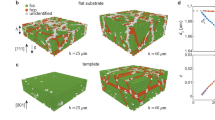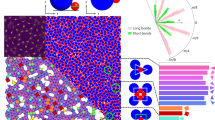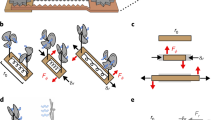Abstract
The competition between thermal fluctuations and potential forces governs the stability of matter in equilibrium, in particular the proliferation and annihilation of topological defects. However, driving matter out of equilibrium allows for a new class of forces that are neither attractive nor repulsive, but rather transverse. The possibility of activating transverse forces raises the question of how they affect basic principles of material self-organization and control. Here we show that transverse forces organize colloidal spinners into odd elastic crystals crisscrossed by motile dislocations. These motile topological defects organize into a polycrystal made of grains with tunable length scale and rotation rate. The self-kneading dynamics drive super-diffusive mass transport, which can be controlled over orders of magnitude by varying the spinning rate. Simulations of both a minimal model and fully resolved hydrodynamics establish the generic nature of this crystal whorl state. Using a continuum theory, we show that both odd and Hall stresses can destabilize odd elastic crystals, giving rise to a generic state of crystalline active matter. Adding rotations to a material’s constituents has far-reaching consequences for continuous control of structures and transport at all scales.
This is a preview of subscription content, access via your institution
Access options
Access Nature and 54 other Nature Portfolio journals
Get Nature+, our best-value online-access subscription
$29.99 / 30 days
cancel any time
Subscribe to this journal
Receive 12 print issues and online access
$209.00 per year
only $17.42 per issue
Buy this article
- Purchase on Springer Link
- Instant access to full article PDF
Prices may be subject to local taxes which are calculated during checkout





Similar content being viewed by others
Data availability
The data contained in the plots within this paper and other findings of this study are available from the corresponding author on reasonable request.
Code availability
The minimal model simulations were performed using freely available HOOMD-Blue codes38. Hydrodynamic simulations were carried out using codes based on the publicly available code at https://github.com/stochasticHydroTools/RigidMultiblobsWall. Input files are available on request to the authors.
References
Jiang, W. et al. Direct observation of the skyrmion Hall effect. Nat. Phys. 13, 162–169 (2017).
Jülicher, F., Ajdari, A. & Prost, J. Modeling molecular motors. Rev. Mod. Phys. 69, 1269 (1997).
Chaikin, P. M., Lubensky, T. C. & Witten, T. A. Principles of Condensed Matter Physics Vol. 10 (Cambridge Univ. Press, 1995).
Strandburg, K. J. Two-dimensional melting. Rev. Mod. Phys. 60, 161–207 (1988).
Bishop, D. J. & Reppy, J. D. Study of the superfluid transition in two-dimensional 4He films. Phys. Rev. Lett. 40, 1727–1730 (1978).
Zahn, K., Lenke, R. & Maret, G. Two-stage melting of paramagnetic colloidal crystals in two dimensions. Phys. Rev. Lett. 82, 2721–2724 (1999).
Alsayed, A. M., Islam, M. F., Zhang, J., Collings, P. J. & Yodh, A. G. Premelting at defects within bulk colloidal crystals. Science 309, 1207–1210 (2005).
Meng, G., Paulose, J., Nelson, D. R. & Manoharan, V. N. Elastic instability of a crystal growing on a curved surface. Science 343, 634–637 (2014).
Thorneywork, A. L., Abbott, J. L., Aarts, D. G. A. L. & Dullens, R. P. A. Two-dimensional melting of colloidal hard spheres. Phys. Rev. Lett. 118, 158001 (2017).
Cafiero, R., Luding, S. & Herrmann, H. J. Rotationally driven gas of inelastic rough spheres. Europhys. Lett. 60, 854 (2002).
Grzybowski, B. A., Stone, H. A. & Whitesides, G. M. Dynamic self-assembly of magnetized, millimetre-sized objects rotating at a liquid–air interface. Nature 405, 1033–1036 (2000).
Yan, J., Bae, S. C. & Granick, S. Rotating crystals of magnetic Janus colloids. Soft Matter 11, 147–153 (2014).
Nguyen, N. H., Klotsa, D., Engel, M. & Glotzer, S. C. Emergent collective phenomena in a mixture of hard shapes through active rotation. Phys. Rev. Lett. 112, 075701 (2014).
Yeo, K., Lushi, E. & Vlahovska, P. M. Collective dynamics in a binary mixture of hydrodynamically coupled microrotors. Phys. Rev. Lett. 114, 188301 (2015).
Kokot, G., Piet, D., Whitesides, G. M., Aranson, I. S. & Snezhko, A. Emergence of reconfigurable wires and spinners via dynamic self-assembly. Sci. Rep. 5, 9528 (2015).
Soni, V. et al. The odd free surface flows of a colloidal chiral fluid. Nat. Phys. 15, 1188–1194 (2019).
Shen, Z. & Lintuvuori, J. S. Two-phase crystallization in a carpet of inertial spinners. Phys. Rev. Lett. 125, 228002 (2020).
Liu, P. et al. Oscillating collective motion of active rotors in confinement. Proc. Natl Acad. Sci. USA 117, 11901–11907 (2020).
Armitage, P. J. Turbulence and angular momentum transport in a global accretion disk simulation. Astrophys. J. Lett. 501, L189 (1998).
Petroff, A. P., Wu, X.-L. & Libchaber, A. Fast-moving bacteria self-organize into active two-dimensional crystals of rotating cells. Phys. Rev. Lett. 114, 158102 (2015).
Oppenheimer, N., Stein, D. B. & Shelley, M. J. Rotating membrane inclusions crystallize through hydrodynamic and steric interactions. Phys. Rev. Lett. 123, 148101 (2019).
van Zuiden, B. C., Paulose, J., Irvine, W. T. M., Bartolo, D. & Vitelli, V. Spatiotemporal order and emergent edge currents in active spinner materials. Proc. Natl Acad. Sci. USA 113, 12919–12924 (2016).
Aubret, A., Youssef, M., Sacanna, S. & Palacci, J. Targeted assembly and synchronization of self-spinning microgears. Nat. Phys. 14, 1114–1118 (2018).
Snezhko, A. Complex collective dynamics of active torque-driven colloids at interfaces. Curr. Opin. Colloid Interface Sci. 21, 65–75 (2016).
Scholz, C., Engel, M. & Pöschel, T. Rotating robots move collectively and self-organize. Nat. Commun. 9, 931 (2018).
Kokot, G. et al. Active turbulence in a gas of self-assembled spinners. Proc. Natl Acad. Sci. USA 114, 12870–12875 (2017).
Lim, M. X., Souslov, A., Vitelli, V. & Jaeger, H. M. Cluster formation by acoustic forces and active fluctuations in levitated granular matter. Nat. Phys. 15, 460–464 (2019).
Bouchet, F. & Venaille, A. Statistical mechanics of two-dimensional and geophysical flows. Phys. Rep. 515, 227–295 (2012).
Baroud, C. N., Plapp, B. B., She, Z.-S. & Swinney, H. L. Anomalous self-similarity in a turbulent rapidly rotating fluid. Phys. Rev. Lett. 88, 114501 (2002).
Korving, J., Hulsman, H., Knaap, H. & Beenakker, J. Transverse momentum transport in viscous flow of diatomic gases in a magnetic field. Phys. Lett. 21, 5–7 (1966).
Hoyos, C., Moroz, S. & Son, D. T. Effective theory of chiral two-dimensional superfluids. Phys. Rev. B 89, 174507 (2014).
Wiegmann, P. & Abanov, A. G. Anomalous hydrodynamics of two-dimensional vortex fluids. Phys. Rev. Lett. 113, 034501 (2014).
Souslov, A., Dasbiswas, K., Fruchart, M., Vaikuntanathan, S. & Vitelli, V. Topological waves in fluids with odd viscosity. Phys. Rev. Lett. 122, 128001 (2019).
Banerjee, D., Souslov, A., Abanov, A. G. & Vitelli, V. Odd viscosity in chiral active fluids. Nat. Commun. 8, 1573 (2017).
Han, M. et al. Fluctuating hydrodynamics of chiral active fluids. Nat. Phys. 17, 1260–1269 (2021).
Eyink, G. L. & Sreenivasan, K. R. Onsager and the theory of hydrodynamic turbulence. Rev. Mod. Phys. 78, 87 (2006).
Lavergne, F. A., Aarts, D. G. & Dullens, R. P. Anomalous grain growth in a polycrystalline monolayer of colloidal hard spheres. Phys. Rev. X 7, 041064 (2017).
Anderson, J. A., Glaser, J. & Glotzer, S. C. HOOMD-blue: a Python package for high-performance molecular dynamics and hard particle Monte Carlo simulations. Comput. Mater. Sci. 173, 109363 (2020).
Peierls, R. Reports on progress of physics. Phys. Soc. VI, 78 (1939).
Nabarro, F. Dislocations in a simple cubic lattice. Proc. Phys. Soc. 59, 256 (1947).
Schall, P., Cohen, I., Weitz, D. A. & Spaepen, F. Visualization of dislocation dynamics in colloidal crystals. Science 305, 1944–1948 (2004).
Weinberger, C. R. & Cai, W. Surface-controlled dislocation multiplication in metal micropillars. Proc. Natl Acad. Sci. USA 105, 14304–14307 (2008).
Irvine, W. T. M., Hollingsworth, A. D., Grier, D. G. & Chaikin, P. M. Dislocation reactions, grain boundaries and irreversibility in two-dimensional lattices using topological tweezers. Proc. Natl Acad. Sci. USA 110, 15544–15548 (2013).
Amir, A. & Nelson, D. R. Dislocation-mediated growth of bacterial cell walls. Proc. Natl Acad. Sci. USA 109, 9833–9838 (2012).
Deutschländer, S., Dillmann, P., Maret, G. & Keim, P. Kibble-Zurek mechanism in colloidal monolayers. Proc. Natl Acad. Sci. USA 112, 6925–6930 (2015).
Braverman, L., Scheibner, C. & Vitelli, V. Topological defects in non-reciprocal active solids with odd elasticity. Preprint at https://arxiv.org/abs/2011.11543 (2020).
Sanchez, T., Chen, D. T., DeCamp, S. J., Heymann, M. & Dogic, Z. Spontaneous motion in hierarchically assembled active matter. Nature 491, 431–434 (2012).
Dahler, J. S. & Scriven, L. E. Theory of structured continua. I. General consideration of angular momentum and polarization. Proc. R. Soc. Lond. A Math. Phys. Eng. Sci. 275, 504–527 (1963).
Tsai, J.-C., Ye, F., Rodriguez, J., Gollub, J. P. & Lubensky, T. C. A chiral granular gas. Phys. Rev. Lett. 94, 214301 (2005).
Scheibner, C. et al. Odd elasticity. Nat. Phys. 16, 475–480 (2020).
Epstein, J. M. & Mandadapu, K. K. Time-reversal symmetry breaking in two-dimensional nonequilibrium viscous fluids. Phys. Rev. E 101, 052614 (2020).
Acknowledgements
We acknowledge discussions with P. Wiegmann, A. Abanov, D. Nelson, C. Scheibner, M. Han, M. Fruchart, S. Gokhale, N. Fakhri and J. Dunkel. We thank V. Vitelli for an insightful discussion on the importance of odd stress on defect motility. We thank W. Yan for useful conversations. This work was primarily supported by the University of Chicago Materials Research Science and Engineering Center, which is funded by the National Science Foundation (NSF) under award no. DMR-2011854. Additional support was provided by NSF DMR-1905974, NSF EFRI NewLAW 1741685 and the Packard Foundation. M.J.S. acknowledges support from NSF grants DMR-1420073 (NYU-MRSEC) and DMR-2004469. D.B. acknowledges support from ARN grant WTF and IdexLyon Tore. E.S.B. was supported by the National Science Foundation Graduate Research Fellowship under grant no. 1746045. D.B. and W.T.M.I. gratefully acknowledge support from the Chicago-France FACCTS programme. F.B.U. acknowledges support from ‘la Caixa’ Foundation (ID 100010434), fellowship LCF/BQ/PI20/11760014 and from the European Union’s Horizon 2020 research and innovation programme under Marie Skłodowska-Curie grant agreement no. 847648. The University of Chicago’s Research Computing Center and the University of Chicago’s GPU-based high-performance computing system (NSF DMR-1828629) are acknowledged for access to computational resources and the Chicago MRSEC (US NSF grant no. DMR-2011854) for access to its shared experimental facilities.
Author information
Authors and Affiliations
Contributions
E.S.B. designed and performed experiments and analysed data. Y.A.G. designed and performed minimal model simulations and elastic theory. F.B.U. designed and performed fully hydrodynamic simulations. V.S. and S.M. contributed to experiments and analytical tools. A.P., D.B., Y.A.G., E.S.B., W.T.M.I. and M.J.S. performed continuum modelling. W.T.M.I., D.B. and M.J.S. designed and supervised research. All authors discussed the results and analysis.
Corresponding authors
Ethics declarations
Competing interests
The authors declare no competing interests.
Additional information
Peer review information Nature Physics thanks Juho Lintuvuori and the other, anonymous, reviewer(s) for their contribution to the peer review of this work.
Publisher’s note Springer Nature remains neutral with regard to jurisdictional claims in published maps and institutional affiliations.
Supplementary information
Supplementary Information
Supplementary materials single file including Supplementary Figs. 1–54.
Rights and permissions
About this article
Cite this article
Bililign, E.S., Balboa Usabiaga, F., Ganan, Y.A. et al. Motile dislocations knead odd crystals into whorls. Nat. Phys. 18, 212–218 (2022). https://doi.org/10.1038/s41567-021-01429-3
Received:
Accepted:
Published:
Issue Date:
DOI: https://doi.org/10.1038/s41567-021-01429-3
This article is cited by
-
Pattern formation by turbulent cascades
Nature (2024)
-
Complex motions emerge from robot interactions
Nature (2024)
-
Non-reciprocal topological solitons in active metamaterials
Nature (2024)
-
Simultaneous emergence of active turbulence and odd viscosity in a colloidal chiral active system
Communications Physics (2023)
-
Odd living matter defies the golden rule of mechanics
Nature (2022)



